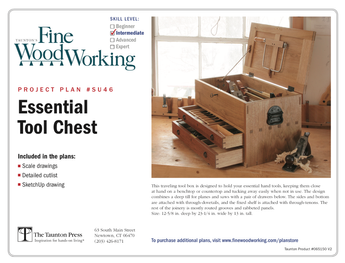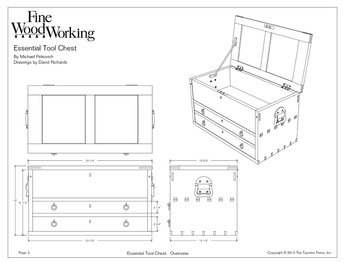Rikon 10-326 fence is terrible
My nephew and I have recently bought new Rikon 10-326 bandsaws.
I’ve had mine for 4 months. In that time I’ve never gotten consistent rip cuts in any thickness of material. I’ve tried everything from white pine to maple. Until this morning I thought it was my technique or something with my materials. Today I saw the unfixed end of the fence moving all over whenever I applied pressure to the outside of the cut. It’s now so obvious this is a design flaw. The drift control allows the fence pivot against the attachment screw and the cam that is supposed to allow fine control of the fence. I’m sure I could use an after market Kreg but that doesn’t solve the primary issue of a major tool manufacture selling useless components. This is unacceptable for a tool that costs $1300+, no one should have to go through the waste of both time and materials. Has anyone experienced similar issues or found solutions?















Replies
I don't know anything about your particular issue.
But did you call Rikon for support / help?
I ask only because in the past when I called them for help I got a human being answering the phone almost immediately. They always were able to get a knowledgeable person to answer my questions ( and my machine wasn't even a Rikon! - turns out Jet and Rikon share the same insides for some power tools and Jet was not being helpful)
Thanks. I did send a note to them today, the company was all out for a company meeting. I’ve found some postings some other message boards about the rikon fence.
I’m stunned that this machine gets good reviews. I’m sure it has nothing to do with the advertising dollars that rikon spends in publications and co-marketing with major vendors like woodcraft and rockler.
It is unlikely this fence is going anywhere, you probably have an alignement problem between the blade and the fence/table. If in doubt, remove the fence and clamp a wooden fence to the table in the exact same location.
I tried to tell myself the same thing for weeks, that it was me.
I hate to be contentious but you are incorrect. I have multiple accounts from across the internet along with my experience and the experience of my nephew at completely different times. The mechanism that is supposed to prevent drift is a spring on the screw that acts as a clamp between the fence and the sliding fence bracket combined with a cam that is used to align the fence with the blade and mitre slot. Applying pressure on the exiting material will force the end of the fence to move in the direction of said pressure. The only way to prevent the motion is by clamping the end of the fence or clamping a board adjective to the fence.
Hard to tell the reason the spring is there but once you tighten side knob , it should completely compress the spring or bottom out the fence against the casting and not be an issue.
Align the blade so the drift is parallel to the miter slot as per this FWW video w/ Michael Fortune
https://www.youtube.com/watch?v=vNdrkmx6ehI
Align the fence to the miter slot using the cam.(Easy to check before each use).
the Rikon has a left miter slot so this is easy.
make sure the cam locking mechanism is tight..
And after setting the fence for width of cut.
clamp a block of wood behind then far end of the fence to prevent the far end of the fence from flexing...
This isn't the question the OP is asking. They're asking about the the fence moving.
I think you skipped over this part of the OP question. "Has anyone experienced similar issues or found solutions?"
By aligning the blade drift parallel with the table's miter slots, the "finicky alignment process" that rjlii talks about (see post #11) is eliminated since the cam adjustment can easily be accidentally moved..
the alignment of the table to the blade's drift Allows the setting of the fence drift to be done quickly and repeatable.. and there is the key, quickly and repeatable.
And then to solve the fence flexing away from the blade near the far end.
using a block clamped behind the fence at the far end prevents the fence from flexing away from the blade at the far end...
I've had an issue with a Rikon fence flexing at that point. I wound up just cutting a simple wooden wedge to jam between the extrusion and the mount giving it two points of contact and fixing it easily.
I agree, it's an odd design.
The 2 points of contact being the cam and the wedge ?
Yes. Next time I'm in the FW shop I'll take a photo.
Thanks, Ben! I think I know what you're saying, but the picture would be great
I fight with mine as well. Every time I resaw I have to go through a finicky alignment process and make sure everything is locked down tight. If you rely on the spring and the cam the fence will move. It just does. Further complicating things is the fact that the knobs are poorly sized. It’s a poorly designed alignment system. Aligning table to blade is a PITA as well.
Unfortunately they baked in a solution seeking a problem, and it created one on its own. I spent a number of years doing custom machine design. The engineer is compelled to build in ways to adjust things in order to get things dialed in to compensate for dimensional variables. This just introduces more variables. There’s a saying in the design trade: “if you make something adjustable, someone will adjust it.” You’re better off getting it right to begin with. Many other manufacturers have a fence system with an alignment approach that is much more effective.
Should try aligning the table... so the whole setting the drift is making sure the fence is parallel with the miter slot... the Rikon has both a left and right miter slot, which make this adjustment easy.. not all bandsaws have a left miter slot.. I agree setting the table is a pain but it either a lot of pain up front or frustration every time the bandsaw is used with the fence...
And I thought the definition of resaw was "a finicky process".
I’ve been in contact with Rikon whose first response is that we’ve sold thousands of these saws, they must be ok! Obviously, we have many woodworkers who beg to disagree.
Had I asked this question before I purchased this engineers challenge I’d be spending my day making sawdust.
You can't trust someone that answers a straight question with a statistic. I declined to hire a plumber recently... I asked him a question related to my project and his answer was "I've been doing this for 30 years." Next!!
ive always said anyone who throws the time theyve been doing something out there like that is going to prove to be a problem.
Its a reliable indicator for sure.
My opinioin is OPs mistake started at the name "Rikon"
Looking at the design of the fence the aluminum extrusion is only supported for a few inches. I can see how this would allow flex given enough load. My Griz fence has cast iron running the full depth (width?) of the table. There is probably 30-odd square inches of cast iron support behind the aluminum extrusion. It is far from my favorite fence but is solid once locked down.
There are certainly solid resaw designs out there in 14" saws but I wonder if you are over-driving your headlights on this particular machine(?). I'm not trying to be a smarty-pants. It is just that machines have a designed operational range. I would not want to push a 10" tall piece of 16/4 along that fence design.
I totally get not expecting to have to retrofit a 14" machine at that price point. I have had machines that I have had to put a bit of sweat equity into but they were discount priced. My dad always said "time or money; one way or the other, you're gonna pay".
Given your current issue, I'd probably go to the Kreg fence. And yes, it really is unacceptable that you have to do this but if it solves the problem, then at least one headache in life is past you. If it doesn't maybe then you can return the Kreg fence and then deal with some sort of looming issue. I've seen all sorts of things on new automobiles where if the manufacturers would spend just a bit more certain problems would be avoided. They don't and I've just learned to bit the bullet and spend the money myself. I'm trying very hard to not start a rant on this and I feel like I'm half way there so I will stop.
Agree on recommendation to use a Kreg fence. I have one on my Jet bandsaw. Works very well. ...Tom
Just curious, what has your nephew's experience been like?
I've owned a Rikon 10-325 saw for, I think, 10+ years and the Rikon supplied fence was bad when I set the saw up. Rikon quickly sent me a new fence when I reported problems with it. However, I had problems with that fence also. I don't remember, but I think I gave up with Rikon at that point and replaced the fence with Carter's Magnafence. Now, since I have bandsaw set up and reset it every time I change blades, I just install the Magnafence at the appropriate rip width measure from 2 points to the miter slot. All my rips and resaws are eseentially perfect. Good cuts result from proper bandsaw setup and a good fence. Based on my experience, Rikon's fence is not a good, useful fence. I bought a 10" bandsaw for cutting curves and found the fence on that saw to be equally as useless but, since I really don't use that saw for ripping or resawing it doesn't matter. Rikon's saw it self is a great saw. The fences on their 14" and 10" aren't good. Maybe they have better ones on their larger saws.
This was a long answer to the only solution for me was to use an after market fence of some sort.
I have a Wen 10" saw and had given up on straight resaw, but I kept trying things. It turned out to be a combination of the right blade and blade tension along with the blade running in the center of the tire.
For me a thin 1/2 in. blade with 3 tpi and a magnetic blade tension setting device were the key. I can cut a straight resaw line. I just have to remember to take the tension off after use.
Since I don't have a good fence, I'm not sure where the cut will be, but it is straight.
For some reason, although Rikon makes a great 14" bandsaw (my opinion), they just can't seem to get the fence right (also my opinion). Too bad, because many of us frequently use the bandsaw for resawing. My advice, concerning Rikon's fences, is to abandon Rikon's and either make your own (plenty of sources like YouTube for possible fences, especially for resawing) or find an after market fence that works with your saw. Proper setup does not seem to be the issue with Rikon's fences.
I went with the Carter Magnafence because it's quick and easy to get setup and square to the blade, but only if the bandsaw itself is setup correctly for resawing, including guides, proper position onf the wheels, and tension (although there are ranges of tension for each saw that work). Another thing I learned over time is that dedicating a blade to resawing is a good idea since cutting curves with the same blade can sometimes take the temper out of the teeth when the curves are severe. Lastly, using a 3/4" blade on a 14" saw may sem like a good idea but a 3/4" blade may require more of the saw's motor power to keep it at the proper speed, thus sometimes making cut quality suffer rather than improve. A 1/2" blade is all that is needed. I've even demos where a 3/8" blade is used with results comparable to a 1/2".
A good source I recommend for setup is Alex Snodgrass's videos on setup, which includes blade position on the wheels, proper positioning of the guides and support bearings, as well as tension and squaring up the table. Once you do it a couple of times it becomes a relatively fast process and allows checking of the saw periodically. Once all of the steps are done correctly resawing results skyrocket. Also, using a blade that no more than 4 TPI is essential (actually 3 TPI works better).
Carter used to also publish a booklet containing Alex's process. I finf that it is always a good reference for me since I don't really require frequent changes in blades.
Trying to use a bandsaw as a Sawmill? Can do but not necessarily with a factory fence. Even aftermarket fences are sometimes challenging. There are a ton of solutions using a fence but the BEST solution out there is the no fence solution, the "Little Ripper" from Stockroom Supply in Canada. Ethan answers a lot of questions regarding "Drift", etc., Take a peek and see what you think.
https://www.youtube.com/playlist?list=PLFVdUVDnyXh-Ikl5g1syiQaq1iARlHDVO
For all of you out there that have had "GREAT EXPERIENCES" using a fence, I get that, but this product simplifies the whole process and makes the the resaw issue a NON-ISSUE. Even when making veneer. Good luck to you.
The Little Ripper is indeed a great tool. I use my friend's for the rare times I've cut up small logs on my bandsaw. However, the OP didn't seem to be asking about using his bandsaw as a sawmill; only for 2 of the functions which a good bandsaw is intended to do, ripping and resawing. For that, a Little Ripper maybe a good accessory, but a very expensive accessory for doing 2 basic bandsaw functions. The fence on my Rikon 10-325 (prior model to the 326) was useless and I quickly put it on the side and replaced it, as I said, with the Carter MagnaFence. I'm only explaining this because it's really unnecessary to buy an expensive accessory like a Little Ripper when you merely need to resaw and rip. These two functions a good bandsaw with a good fence should do after proper setup. I'm not sure why Rikon has persisted all these years in insisting their fence is OK on the 14" saw. It isn't and hasn't been for awhile.
I have the Record Power Sabre 350, which uses the identical fence system, and it's solid as a rock.
The knob on the back side (which includes the spring in its assembly) should be tightened fully, as its only purpose is to lock the fence onto the sliding mechanism. If it still wobbles, look for the reason why it's not seating solid. Indeed, something might not be machined right.
You align the fence using the vertical double knob. Used the top one to change the angle, and lock it down using the konb underneath.
Get rid of drift by adjusting the blade, not the fence. See the videos others posted.
You're definitely not alone—I've had a very similar experience. I picked up mine about six months ago and struggled with inconsistent rip cuts from day one, especially when working with anything wider than a few inches. Like you, I initially chalked it up to user error or wood movement, but eventually noticed the exact same thing: the far end of the fence drifts under even moderate lateral pressure. Once you see it happening, it's hard to ignore.
The issue seems to stem from the design of the fence mounting system and the reliance on that single pivot point. It introduces just enough play to throw off your accuracy, especially if you're trying to get clean repeatable rips.
A few things that helped (though they don't solve the underlying design flaw):
I added a second aftermarket clamp to the outfeed side of the fence during cuts. It’s not ideal, but it minimizes movement.
I also squared up the fence to the miter slot every time I make a new setup. It’s a hassle, but it helps reduce variation.
Some users have had success replacing the stock fence altogether with a Kreg or Incra system, though as you mentioned, that’s frustrating considering the price of the tool.
Totally agree that this is disappointing on a $1300+ tool. It feels like something that should have been caught in prototyping. Hopefully more users speak up—maybe we’ll see a retrofit or at least some official acknowledgment.
Curious to hear if anyone else has found a more permanent solution.
People used to retrofit a different brand fence to tablesaws all the time. It was a common upgrade. Pretty much assumed. Built into the budget and purchasing decision. Why dig your heels in on the factory fence? An inherently bad design won't fix itself. If jury-rigging something will stick in your craw (I'm with you), move on to something else.
I haven't bought a bandsaw in years, but I'd be shocked if somebody doesn't make a better, aftermarket fence for the saw in question. Surely a few hundred bucks vs. lost time futzing around not to mention bad cuts on expensive material is worth it?